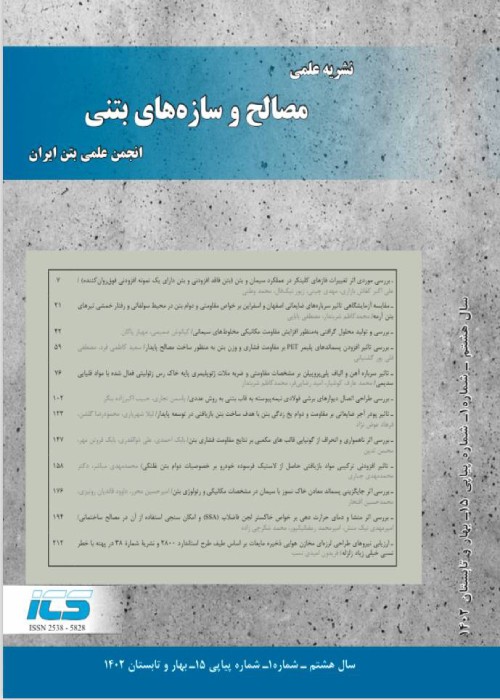The Effect of Iron Slag and Polypropylene Fibers on the Strength and Impact Characteristics of Geopolymer Mortar based on Zeolite Clay Activated with Sodium Alkali Substances
Author(s):
Article Type:
Research/Original Article (دارای رتبه معتبر)
Abstract:
In light of the adverse ecological outcomes of cement production, researchers are exploring alternative materials that can replace cement in construction while maintaining environmental compatibility. An alternative strategy is the use of soil base materials containing aluminum silicate with alkaline activators and industrial waste. This study aims to evaluate the strength and durability properties of geopolymer mortar relative to cement and clay-based mortars. Eight mixing designs were employed, including two for cement and clay-based mortars for comparison, and six for geopolymer mortars. The geopolymer mortars tested comprised 0%, 30%, and 40% slag, with 0.1% polypropylene fibers used in three designs. A 12 M concentration of sodium hydroxide solution and a sodium silicate to sodium hydroxide ratio of 2.5 were utilized in this study. The samples were subjected to compressive and tensile strength evaluations at 7, 28, 54, and 90-day intervals. Additionally, water absorption, capillary water absorption, and impact resistance tests were performed after 28 days. The compressive strength test conducted after 28 days revealed that geopolymer mortars that contained either 30% or 40% slag, along with polypropylene fibers, achieved 53% and 73% of the compressive strength of the cement sample, respectively. This increase represented a 3.6 to 9-fold improvement over clay-based samples. The tensile strength of the geopolymer samples was found to be 53% and 63% of the strength of the cement, but 5 and 9.5 times higher than the clay-based sample, respectively. The results showed that the use of polypropylene fibers in geopolymer samples containing 30 and 40% slag reduced water absorption, but compared to cement samples, they absorbed 95 and 72% more water after 72 hours. The coefficient of capillary absorption in all geopolymer samples was high, but the use of fibers in the sample containing 40% slag resulted in a 1% reduction in this coefficient compared to the non-fiber sample. Cracking resistance tests were conducted on the geopolymer samples, which showed that the samples containing 30 and 40% slag with fibers achieved 40 and 73% of the cracking resistance of the cement sample, respectively. The destruction resistance of the sample containing 30% slag with fibers was approximately 46% of the cement resistance, while the model containing 40% slag with fibers exhibited a 15% improvement relative to the cement sample.
Keywords:
Language:
Persian
Published:
Journal of Concrete Structure and Materials, Volume:8 Issue: 1, 2024
Pages:
76 to 101
magiran.com/p2696207
دانلود و مطالعه متن این مقاله با یکی از روشهای زیر امکان پذیر است:
اشتراک شخصی
با عضویت و پرداخت آنلاین حق اشتراک یکساله به مبلغ 1,390,000ريال میتوانید 70 عنوان مطلب دانلود کنید!
اشتراک سازمانی
به کتابخانه دانشگاه یا محل کار خود پیشنهاد کنید تا اشتراک سازمانی این پایگاه را برای دسترسی نامحدود همه کاربران به متن مطالب تهیه نمایند!
توجه!
- حق عضویت دریافتی صرف حمایت از نشریات عضو و نگهداری، تکمیل و توسعه مگیران میشود.
- پرداخت حق اشتراک و دانلود مقالات اجازه بازنشر آن در سایر رسانههای چاپی و دیجیتال را به کاربر نمیدهد.
In order to view content subscription is required
Personal subscription
Subscribe magiran.com for 70 € euros via PayPal and download 70 articles during a year.
Organization subscription
Please contact us to subscribe your university or library for unlimited access!


